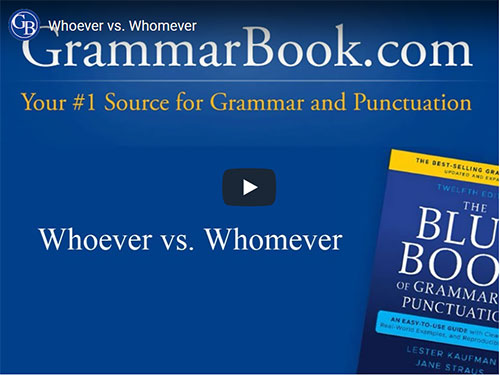|
Arranging Multiple Adjectives
|
|
We know an adjective is a word that describes or modifies a noun. We also know that in English adjectives almost always precede their noun, unlike languages such as Spanish and French, in which adjectives more commonly can be placed either before or after a noun depending on their function or emphasis.
Understanding adjectives' position in a sentence, how then do we order them when several are strung together?
If working with only two adjectives, many of us will follow our instincts and preferences. For example, if we write a phrase such as the black, round talisman, we lead with the color to emphasize it. If we write the round, black talisman, we aim to stress its shape.
When we move up to three adjectives before a noun, descriptions start to either lose or seek their place in line. For instance, would we write the Swedish, square, delicious dessert or the delicious, square, Swedish dessert?
The good news is English offers direction on adjective sequencing. We researched multiple sources for such grammatical guidance. They are not uniform in their suggested order of adjectives, but they provide almost the same components with only a few variances in arrangement and labeling.
For our current discussion, we will refer mainly to the preferred guidelines from perhaps the most recognized source we researched, the online Cambridge Dictionary. According to Cambridge, if we are writing several adjectives before a noun without a preferred order for emphasis, we can arrange them as follows based on their function:
| 1 quantity |
one, two, four |
|
7 color |
black, white, red |
| 2 opinion |
talented, pretty, boring |
|
8 pattern |
striped, spotted, checked |
| 3 size |
big, small, tall |
|
9 origin |
Swedish, African, Cuban |
| 4 condition or quality |
lean, easy, cold |
|
10 material |
glass, wood, brick |
| 5 shape |
square, round, flat |
|
11 type |
boxed, exposed, all-inclusive |
| 6 age |
old, young, ancient |
|
12 purpose |
cooking, sleeping, teaching |
(Note that we modified the table by adding quantity [1] and pattern [8], which appeared among other resources but not with Cambridge.)
Whether in writing or speaking, in daily use we will often not read or hear descriptive words strictly in this order; these guidelines are not fixed. Rather, they serve as a road map for communication that sounds more sequentially natural when needed. In addition, using more than three adjectives before a noun is rare and generally not recommended.
With that being said, using the table above, we can form descriptive expressions with some direction.
Examples:
I would like a piece of the delicious [opinion], square [shape], Swedish [origin] dessert.
Do you still wear those old [age] white [color] shoes?
Those two [quantity] tall [size], lean [physical quality] men work for the firm.
The professor's four [quantity] old [age], boxed [type] teaching [purpose] files are sure to aid the defense. |
(To review or learn more about punctuating adjectives, see Rule 2 of Commas and our article Commas, Part 3.)
For many of us, our ear for language and our intentions for emphasis will continue to inform how we arrange descriptive words. Should we be in doubt, we can simply refer to the table and help our adjectives find a sense of proper place.
|
View and comment on this
article on our website.
|
|
|

|
Pop Quiz
In the following sentences, identify the suggested order of the adjectives according to the table in this article.
1. The ________ movie is putting me to sleep.
a) boring, old
b) old, boring
2. The group of ________ musicians just emerged from the plane.
a) Cuban, young, talented
b) talented, young Cuban
c) young, talented Cuban
3. They want ________ boxes for their project.
a) two small, flat wood
b) small two, wood, flat
c) two wood, flat small
|
 |
The Blue Book of Grammar and Punctuation
by Lester Kaufman and Jane Straus |
The Authority on English Grammar! Twelfth Edition Now Available
An indispensable tool for busy professionals, teachers, students, homeschool families, editors, writers, and proofreaders.
Available in print AND as an e-Book! Over 2,000 copies are purchased every month!
To order the book, simply click the link to order the book from the GrammarBook.com website.
|
Free BONUS Quiz for You!
[[firstname]], because you are a subscriber to the newsletter, you get access to one of the Subscribers-Only Quizzes. Click here to take a Confusing Words and Homonyms Quiz and get your scores and explanations instantly!
We will be adding many more quizzes this year to our already substantial list of them. If you have suggestions for topics we have not yet covered, please send us a message at help@grammarbook.com.
|
Hundreds of Additional Quizzes
at Your Fingertips
Subscribe now to receive hundreds of additional English usage quizzes not found anywhere else!
Teachers and Employers
Save hours of valuable time! You may assign quizzes to your students and employees and have their scores tallied, organized, and reported to you! Let GrammarBook.com take the hassle out of teaching English!
"Fun to test my skills."
"The explanations really help ... thanks!"
"I can select the quizzes to assign to my students, and then the results are reported to me automatically!"
If you think you have found an error in a quiz, please email us at help@grammarbook.com
|
Wordplay

Pop Quiz Answers
1. The ________ movie is putting me to sleep.
a) boring, old [2 opinion, 6 age]
b) old, boring
2. The group of ________ musicians just emerged from the plane.
a) Cuban, young, talented
b) talented, young Cuban [2 opinion, 6 age, 9 origin]
c) young, talented Cuban
3. They want ________ boxes for their project.
a) two small, flat wood [1 quantity, 3 size, 5 shape, 10 material]
b) small two, wood, flat
c) two wood, flat, small
|
 |
English in a Snap:
68 One-Minute English Usage Videos FREE |
Learn all about who and whom, affect and effect, subjects and verbs, adjectives and adverbs, commas, semicolons, quotation marks, and much more by just sitting back and enjoying these easy-to-follow lessons. Share them with your colleagues (and boss), children, teachers, and friends as well! Click here to watch.
|
|





